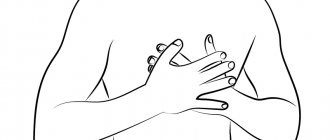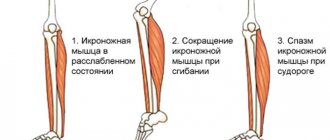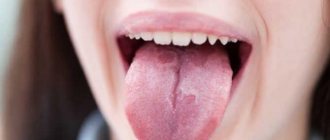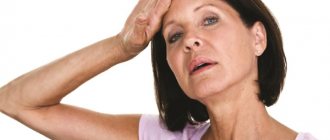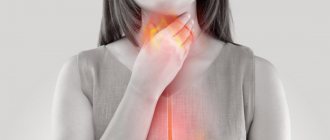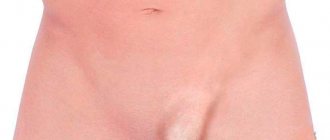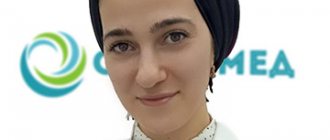Lumbar radiculopathy (radicular syndrome) is a neurological condition caused by compression of one of the L1-S1 roots, which is characterized by low back pain radiating to the leg. Compression of the root can be manifested not only by pain (sometimes of a shooting nature), but also by impaired sensitivity, numbness, paresthesia or muscle weakness. Radiculopathy (radicular syndrome) can occur in any part of the spine, but it most often occurs in the lumbar region. Lumbosacral radiculopathy occurs in approximately 3-5% of the population, in both men and women, but, as a rule, the syndrome occurs in men at the age of 40 years, and in women the syndrome develops between the ages of 50 and 60 years. Treatment of radicular syndrome of the lumbosacral spine can be carried out using both conservative methods and surgical techniques.
Causes
Any morphological formations or pathological processes that lead to compression effects on the nerve root can cause radicular syndrome.
The main causes of lumbar radiculopathy are:
- A disc herniation or bulge can put pressure on the nerve root and lead to inflammation in the root area.
- A degenerative disease of the joints of the spine that results in the formation of bone spurs on the facet joints, which can lead to a narrowing of the intervertebral space, which will put compression on the nerve roots.
- Trauma or muscle spasm can put pressure on the root and cause symptoms in the area of innervation.
- Degenerative disc disease, which leads to wear and tear of the intervertebral disc structure, and a decrease in the height of the discs, which can lead to a decrease in the free space in the intervertebral foramen and compression of the root as it exits the spinal column.
- Spinal stenosis
- Tumors
- Infections or systemic diseases
In patients under 50 years of age, the most common cause of radicular syndrome in the lumbar spine is a herniated disc. After 50 years of age, radicular pain is often caused by degenerative changes in the spine (stenosis of the intervertebral foramen).
Risk factors for developing lumbar radiculopathy:
- age (45-64 years)
- smoking
- mental stress
- Strenuous physical activity (frequent heavy lifting)
- Driving or vibration exposure
Which doctor should I contact?
In case of a pinched nerve in the back, a person is recommended to contact the following specialists:
- Neurologist. In addition to the examination, the doctor will send you for x-rays and tomography. The results obtained will help make a decision in making a diagnosis: whether the nerve endings are damaged, whether the spinal discs are displaced. The specialist will prescribe treatment, which will consist of using pain-relieving injections and warming gels.
- Surgeon
. A doctor can diagnose a herniated disc. The treatment prescribed is surgery to remove the hernia. The recovery period takes place under the supervision of a neurologist. - Chiropractor. The specialist will relieve the pain caused by the displacement of the vertebrae. The doctor’s main goal is to free the nerve from its compressed state. If the course of the disease is not complicated, then the result can be achieved in one visit.
- Osteopath. When examining a patient, a specialist determines the cause of pain, uses hand touches to return the vertebrae to their place, and relieves tension from the muscles. The osteopath works on the entire spine, which helps avoid compression of nerve endings in the future.
Symptoms
Symptoms resulting from radicular syndrome (radiculopathy) are localized in the area of innervation of a particular root.
- Back pain radiating to the buttock, leg and extending down behind the knee, into the foot - the intensity of the pain depends on the root and the degree of compression.
- Disruption of normal reflexes in the lower limb.
- Numbness or paresthesia (tingling) may occur from the lower back to the foot, depending on the area of innervation of the affected nerve root.
- Muscle weakness can occur in any muscle innervated by a pinched nerve root. Prolonged pressure on a nerve root can cause atrophy or loss of function of a specific muscle.
- Pain and local tenderness are localized at the level of the damaged root.
- Muscle spasm and postural changes in response to root compression.
- Pain increases with exercise and decreases with rest
- Loss of the ability to make certain movements of the body: inability to straighten back, bend towards the localization of compression, or stand for a long time.
- If the compression is significant, activities such as sitting, standing and walking may be difficult.
- Change in normal lordosis of the lumbar spine.
- Development of stenosis-like symptoms.
- Stiffness in the joints after a period of rest.
Patterns of pain
- L1 - back, front and inner surface of the thigh.
- L2 - back, front and inner surface of the thigh.
- L3 - back and front, and the inner surface of the thigh with a downward extension.
- L4 - back and front of the thigh, to the inner surface of the leg, into the foot and big toe.
- L5 – Along the posterolateral part of the thigh, the front part of the lower leg, the top of the foot and the middle toe
- S1 S2 – Buttock, back of the thigh and lower leg.
The onset of symptoms in patients with lumbosacral radiculopathy (radicular syndrome) is often sudden and includes low back pain.
Sitting, coughing or sneezing can aggravate the pain, which radiates from the buttock down the back of the leg, ankle or foot.
You need to be vigilant for certain symptoms (red flags). These red flags may indicate a more serious condition that requires further evaluation and treatment (eg, tumor, infection). The presence of fever, weight loss, or chills requires careful evaluation.
The patient's age is also a factor when looking for other possible causes of the patient's symptoms. People under 20 years of age and over 50 years of age are at increased risk for more serious causes of pain (eg, tumors, infections).
Causes and symptoms
The back has to withstand extreme stress when lifting heavy objects or making sudden movements. The lower back reacts to such a “stressful” load by causing pain there. Therefore, a person is obliged to balance hard work with his development, since it is extremely dangerous for the lumbar region.
Prices for back belts
The causes of a pinched nerve in the lower back vary widely.
Other causes of pain:
- disruption of the pelvic organs;
- staying in a sitting position for a long time, for example, when working at a computer;
- overstrain of the spine during pregnancy;
- hypothermia of the body;
- displacement of the intervertebral disc - if this puts pressure on the nerves, then the person may develop inflammation;
- poorly chosen position during sleep;
- mattress too soft or too hard;
- excess weight;
- benign or malignant tumor.
Diagnostics
The primary diagnosis of radicular syndrome of the lumbosacral spine is made based on the symptoms of the medical history and physical examination (including a thorough examination of the neurological status). A thorough analysis of motor, sensory and reflex functions allows us to determine the level of damage to the nerve root.
If the patient reports typical unilateral radiating leg pain and there are one or more positive neurological test results, then a diagnosis of radiculopathy is very likely.
However, there are a number of conditions that may present with similar symptoms. Differential diagnosis must be carried out with the following conditions:
- Pseudoradicular syndrome
- Traumatic disc injuries in the thoracic spine
- Damage to discs in the lumbosacral region
- Spinal stenosis
- Cauda equina
- Spinal tumors
- Spinal infections
- Inflammatory/metabolic causes - diabetes, ankylosing spondylitis, Paget's disease, arachnoiditis, sarcoidosis
- Trochanteric bursitis
- Intraspinal synovial cysts
To make a clinically reliable diagnosis, as a rule, instrumental diagnostic methods are required:
- X-rays – can detect the presence of joint degeneration, fractures, bone defects, arthritis, tumors or infections.
- MRI is a valuable technique for visualizing morphological changes in soft tissues, including discs, spinal cord and nerve roots.
- CT (MSCT) provides complete information about the morphology of the bone structures of the spine and visualization of spinal structures in cross section.
- EMG (ENMG) Electrodiagnostic (neurophysiological) studies are necessary to exclude other causes of sensory and motor disorders, such as peripheral neuropathy and motor neuron disease
Conservative treatment:
- Rest: avoid activities that cause pain (bending, lifting, twisting, turning or bending backwards. Rest is necessary for acute pain syndrome
- Drug treatment: anti-inflammatory, painkillers, muscle relaxants.
- Physiotherapy. For acute pain syndrome, the use of procedures such as cryotherapy or chivamat is effective. Physiotherapy can reduce pain and inflammation of the spinal structures. After the acute period has stopped, physiotherapy is carried out in courses (ultrasound, electrical stimulation, cold laser, etc.).
- Corseting. The use of a corset is possible in case of acute pain syndrome to reduce the load on the nerve roots, facet joints, and lumbar muscles. But the duration of wearing a corset should be short, since prolonged fixation can lead to muscle atrophy.
- Epidural steroid injections or facet joint injections are used to reduce inflammation and control pain in severe radicular syndrome.
- Manual therapy. Manipulations can improve the mobility of the motor segments of the lumbar spine and relieve excess muscle tension. Using mobilization techniques also helps modulate pain.
- Acupuncture. This method is widely used in the treatment of radicular syndrome in the lumbosacral spine and helps both reduce symptoms in the acute period and is included in the rehabilitation complex.
- Exercise therapy. Exercise includes stretching and strengthening exercises. The exercise program allows you to restore joint mobility, increase range of motion and strengthen your back and abdominal muscles. A good muscle corset allows you to support, stabilize and reduce tension on the spinal joints, discs and reduce the compression effect on the spine. The volume and intensity of exercise should be increased gradually to avoid relapse of symptoms.
- In order to achieve stable remission and restore full functionality of the spine and motor activity, it is necessary for the patient, after completing the course of treatment, to continue independent exercises aimed at stabilizing the spine. The exercise program must be individual.
What to do if a nerve is pinched in the back?
If a nerve is pinched in the lower back, you should immediately consult a neurologist
.
Based on the tests obtained and identifying the causes, the specialist can make a diagnosis. As a rule, to identify the disease they use: motor tests, MRI
,
x-rays
. Pinching of nerve endings in the lower back is a serious illness that significantly limits motor activity.
First aid
When a nerve is pinched in the back, you need to know what to do and how to alleviate the patient’s condition. At the moment the first symptoms appear, the patient should take a supine position. Every movement will lead to even more acute pain. A comfortable position will reduce pressure on the pinched nerve. What to do if a nerve is pinched in the back? Use available means to provide warmth, for example, wrap a blanket around the problem area. This will minimize pain.
Massage
The first symptoms of a pinched nerve in the back can be eliminated using a simple technique. The massage begins with circular touches in the area of the problem area. They move first up, then down. Whatever technique is chosen, you need to remember that the procedure is intended to relieve pain in the muscles, not the spine. A pinched nerve in the back, the symptoms of which have already appeared, is something that should be entrusted to a chiropractor
.
Exercise therapy and gymnastics
Exercise therapy and gymnastics are prescribed by a doctor as restorative measures. A set of gymnastic exercises to eliminate back pain is carried out only under the supervision of a specialist. The main task is to stabilize the patient’s condition. Exercise therapy minimizes tension and makes joints more mobile.
Orthopedic corsets
As a treatment for a pinched nerve in the back, experts prescribe the use of orthopedic corsets. Their main goal is to force the spinal muscles to maintain posture, relieving strong pressure on the spinal column. The help of elastic corsets is invaluable in relieving stress from the spine.
Drug treatment
Only a doctor can tell you how to treat a pinched nerve in the back and how often to take medications. Painkillers are recommended. For example, Ketorol, Ketanov, etc. They begin to act within a few minutes. Painkillers are also available in the form of gels and ointments. Apply the selected product to the problem area.
Surgery
Surgical methods for the treatment of radicular syndrome in the lumbosacral spine are necessary in cases where there is resistance to conservative treatment or there are symptoms indicating severe compression of the root such as:
- Increased radicular pain
- Signs of increased root irritation
- Muscle weakness and atrophy
- Incontinence or bowel and bladder dysfunction
As symptoms worsen, surgery may be indicated to relieve compression and remove degenerative tissue that is affecting the root. Surgical treatments for radicular syndrome in the lumbosacral spine will depend on which structure is causing the compression. Typically, these treatments involve some way to decompress the spine or stabilize the spine.
Some surgical procedures used to treat lumbar radiculopathy are:
- Fixation of vertebrae (spinal fusion - anterior and posterior)
- Lumbar laminectomy
- Lumbar microdiscectomy
- Laminotomy
- Transforaminal lumbar
intercorporeal fusion - Cage implantation
- Correction of deformity
Types of lower back pain
Nerves in the human body perform various functions and are divided into:
- sensitive;
- motor;
- vegetative.
Lower back pain comes in different forms: it all depends on the affected nerve.
When a sensitive nerve is pinched, a person immediately experiences severe pain in the lower back, which intensifies over time. When a motor or autonomic nerve is pinched, the pain appears after a while, but it is irregular and not too severe.
If a person has a pinched motor nerve, this affects the normal functioning of the musculoskeletal system. If the autonomic nerve is affected, then diseases of the internal organs develop, and the cardiovascular system malfunctions.
Forecast
In most cases, it is possible to treat radicular syndrome in the lumbosacral spine conservatively (without surgical intervention) and restore ability to work. The duration of treatment may vary from 4 to 12 weeks depending on the severity of symptoms. Patients should continue to perform exercises at home to improve their posture, stretching, strengthening, and stabilization. These exercises are necessary to treat the condition causing radicular syndrome.
Other diseases - clinics in
Choose among the best clinics based on reviews and the best price and make an appointment
Family
Scoliosis Treatment Center named after K. Schroth
Moscow, st.
Azovskaya, 24, building 2 POM VI/KOM 5,6,7/ET 1 Sevastopolskaya
+7
- Consultation from 1500
- Exercise therapy from 2700
0 Write your review
Family
Oriental Medicine Clinic "Sagan Dali"
Moscow, prosp.
Mira, 79, building 1 Rizhskaya
+7
- Consultation from 1500
- Diagnostics from 0
- Reflexology from 1000
0 Write your review
Family
Center for Chinese Medicine "TAO"
Moscow, st.
Ostozhenka, 8 building 3, 1st floor Kropotkinskaya
+7
- Consultation from 1000
- Massage from 1500
- Reflexology from 1000
0 Write your review
Show all Moscow clinics
Prevention
The development of radicular syndrome in the lumbosacral spine can be prevented. To reduce the likelihood of developing this condition you should:
- Practice good posture while sitting and standing, including while driving.
- Use proper body mechanics when lifting, pushing, pulling, or performing any activity that places additional stress on the spine.
- Maintain a healthy weight. This will reduce the load on the spine.
- No smoking.
- Discuss your profession with a physical therapy doctor, who can analyze work movements and suggest measures to reduce the risk of injury.
- Muscles should be strong and elastic. It is necessary to consistently maintain a sufficient level of physical activity.
